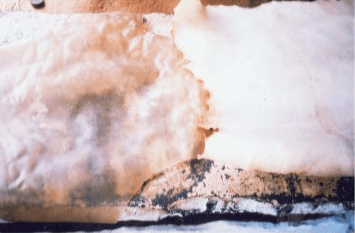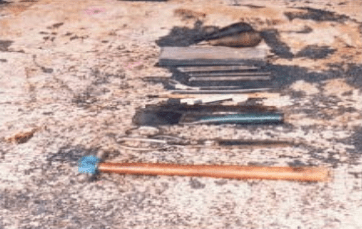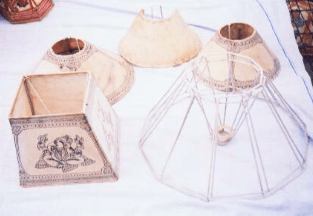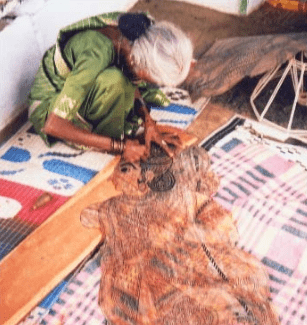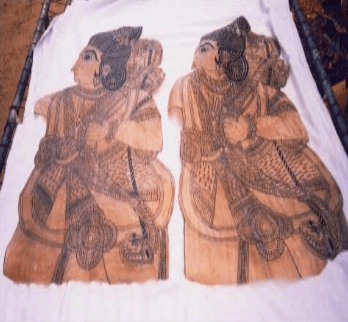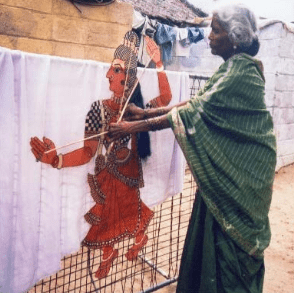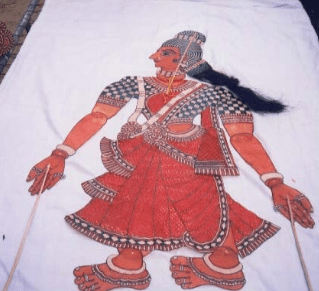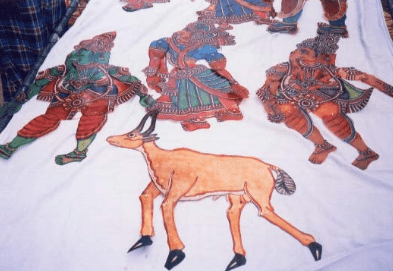Leather Lamp shades
Leather Lamp shades and Puppets are awesome. The craft of making leather puppets is inextricably linked to the traditional folk form of cultural expression, namely, puppetry. Known as tollu bommalu / tollu bommalatta (leather puppets / leather puppetry), this form of shadow-puppet theatre is found in several regions of Andhra Pradesh.
Tollu means leather and bommalu means dolls or figures. According to oral tradition, the form originated in 200 BC when it was patronized by the rulers of the Satvahana dynasty.
In the 16th century during the reign of King Kona Reddy, a ruler of the Vijayanagar Empire, a Telugu manuscript entitled ‘Ramayana Ranganathana’ was composed specifically for the shadow theatre. Besides providing a dramatic text of the famous epic story.
the manuscript also includes instructions for the construction and decoration of puppets. The puppet forms are cut from pieces of hide or stiff parchment, and in Andhra Pradesh, are colored and bigger in size than those in other parts of the country.
Themes from the epics Ramayana and Mahabharata dominate this puppetry, which served as an effective medium of communication.
Regions of Leather Lamp shade
Nimmalakunta in Anantapur district, D.C. Palle in Nellore district, and Narsaraopet in Guntur district are the main centers of leather puppet making in Andhra Pradesh. Of these, Nimmalakunta is well known for artisans practicing this hereditary craft.
Producer Communities of Leather Lamp shade
The main community engaged in this craft is the Marathi Balija, and it is said that these groups originally came from the Marathwada region. In earlier times, puppet making was a flourishing business, especially as puppetry was one of the main forms of entertainment in the villages.
But slowly with the decline in this form of shadow theatre, leather puppet makers are being forced to diversify their ware into making utility items such as colorful lampshades or even toys, in order to cater to a new market.
Raw Materials and Tools Used for Leather Lamp shade
Goat hide and sheepskin are the basic material. In addition, the following are used: water proof colors, hammer, chisel, needle, scissors, paint-brush and mould (for lamp shades). These raw materials are procured from Dharmavaram, Ananthapur, Hindupur, Narsaraopet and Hyderabad.
After the raw material is procured, it has to be cleaned thoroughly in hot water. It is then soaked in a pit of limewater for about 10 days. This softens the upper surface, which is then vigorously cleaned or scraped with a chisel so as to get a smooth surface.
After this initial cleaning, the leather is soaked again, this time along with kadaka powder, which imparts a light brown colour to the leather. The leather is then thoroughly dried, for as long as a week, depending on the weather conditions. After drying the leather is ready for the designs tobe drawn on it.
Making of Leather Lamp Shades:
Lampshades are made with the help of a mould. First the artisan cuts the leather into two equal pieces. One half of the leather is stretched on half the mould, which is then stitched with a needle.
Then the other side of the mould is covered with the other half. Onto this, the artisan makes the designs, which are mainly mythological figures and occasionally his own creations. These drawings are done with a pencil.
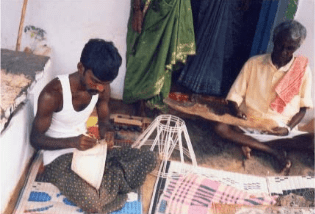
After marking the designs, outlines are painted with black. Thereafter colours are filled in with vegetables dyes -brilliant reds, greens, whites, yellows, browns and orange being the most popular. Chiseling small holes in the decorative patterns enhances the attractiveness of the lampshade.
This is done with a pogaru (chisel). The main part of the article is colored with a brush using water proof colors. These colors are available in the local market. After coloring the figures, the outlines are retraced with black, which gives a certain thickness to the designs. The product is dried in sunlight for a day or two, depending on the climatic conditions.
Making of puppets:
After the leather is smoothed, the craftsperson draws the design on both sides of the leather with pencil. Then the leather is cut as per the shape of the design. Then the outline portion is marked with black color. Design and coloring will be done for both the sides.
After marking the outlines, different colors are filled into the main form. This has to be done painstakingly, and takes considerable time and effort. After coloring, it is dried for two to three days.
This puppet form is then mounted on sticks and bound with ropes for movement. Different parts of the body are separately cut and then tied to each other to allow free movement.
It is interesting to note that while generally puppets are made of goat-skin, some demon puppets are made of buffalo hide, while gods and other heroes are depicted on deerskin.
The size of puppets varies; it is said that puppets from Madanapally and Kakinada go up to 4-5 feet. The leather puppet is wedged into a split bamboo strip and tied along the length of the strip from the head to the crotch to provide support.
Many puppets have movable hands and legs and some, movable heads and necks. While black, red, and green are some of the colors commonly used for the puppets, female figures and sages are characteristically depicted in yellow.
Elaborate ornamentation of puppets indicating jewelry and clothing is also typical. This effect is done by perforating small designs on the skin with the help of sharp chisels.
The coloring of the puppets, as mentioned above, is the most elaborate process in the preparation of the puppets. The designs of the puppets are largely based on the traditional Puranic figures seen in temple sculpture and idols. The product takes thirty to forty days to be completed.
Bringing the puppets to life
These brilliantly crafted puppets were once the mainstay of riveting performances of episodes from the Indian epics. For earlier generations of puppet makers and puppeteers, as many as fifteen performances a month was the norm.
The main puppeteer would stand behind the screen and narrate stories while simultaneously manipulating the movements of figures, so as to convey the full essence of the theme being enacted. Improvisations were not rare, and an interactive performance would make for greater rapport with the audience.
A typical troupe was composed of between six and ten people: manipulators, singers, dancers, and instrumentalists. The sounds and musical accompaniment matched the actions and often regaled the audience throughout the long performance.
Both the Ramayana and Mahabharata stories require at least a hundred puppet figures. A stick holds aloft each puppet form below and the limbs are manipulated by means of strings.
A white screen is stretched across the place of performance, a little above the head of the puppeteers who sit behind. Bright light is thrown from behind the puppets so as to project their shadows on the curtain to be seen by the spectators on the other side.
The colors stand out beautifully and figures are magnified or shortened by varying the distance between the light and the puppets.
Tolu Bommalata is best described as a composite art containing the fine arts of music, sculpture and painting. Now, however, the frequency of performances has reduced drastically and performances are often confined to a few nearby villages.
Marketing of Leather Lamp shade
The market for leather puppets and leather lampshades is through exhibitions and through emporia (such as Lepakshi) and other crafts stores.
According to the craftspersons, the government needs to play a more proactive role in marketing, and in providing infrastructural support such as setting up exclusive showrooms. However, as of now, the main channel for sales is exhibitions in metros and big cities. The export potential exists but does not seem to have been tapped enough.
Designs of Leather Lamp shade and Puppets
Leather puppets being a pre-requisite of a traditional art form like puppetry, the figures, themes, and design motifs have largely been drawn from traditional and religious sources.
Epics like the Ramayana and Mahabharata largely inspire lampshades of different shapes and sizes. Hindu deities such as Ganesh, Vishnu, and Krishna are also depicted on these, as are floral and animal motifs.
Ramayana themes often predominate in the designs, with vivid depictions of Hanuman, Ravana with his ten heads, Vinayaka seated regally. Sundarakanda, Lankadahanam, Ravana Vadha and Laxmana Moksha are all portrayed on these.
Characters from the Panchatantra are also used. In contemporary times, the eye-catching leather puppets double up as wall decorations.
The fact that the product is now a decorative and/or utility item in a modern world has also brought some changes.
The move to make lamp shades instead of leather puppets alone is one such strategy to remain responsive to the changing market. However, design inputs will have to keep in mind the different markets being targeted. What is popular in an export market may not necessarily sell well in national exhibitions; so dual product lines need to be developed.



